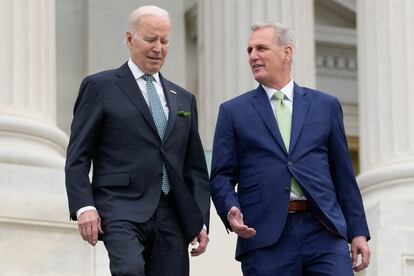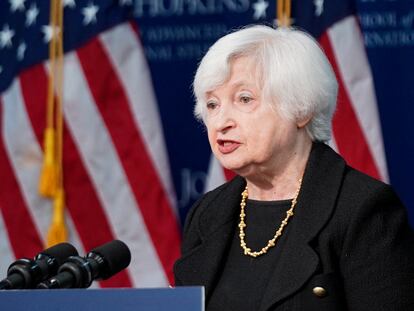US debt ceiling: Will Biden and McCarthy be able to strike a deal on Tuesday?
The president and the House speaker will meet today to discuss the standoff, which, according to a White House report, is already taking a toll on the nation’s economy


Joe Biden and Kevin McCarthy are on a collision course. The president of the United States is calling on Congress to unconditionally raise the debt ceiling, which is close to being reached, while the speaker of the House of Representatives is asking for all kinds of concessions. The two politicians will meet on Tuesday, but given their respective baggage, reaching a deal will prove difficult.
U.S. Treasury Secretary Janet Yellen warned last week that the United States may hit the debt ceiling as early as June 1, but also left open the possibility that this could happen at a later date. The debt limit — now at about $31.4 trillion — was hit in January, and since then the government has been taking extraordinary measures that have given it some temporary breathing space. Moody’s Analytics and investors estimate that the X-date — the day the government will not have enough cash to pay all of the federal government’s bills on time — will come up in mid-August.
Biden called the meeting with McCarthy on May 1, the same day that Yellen announced that the U.S. could default on its debt as early as June 1. The U.S. president has little confidence he will be able to reach a deal with McCarthy on Tuesday. Indeed, the White House has already announced that Biden will visit Hudson Valley on Wednesday to talk about why Congress must increase the debt limit to avoid default “immediately and without conditions.”
Both Biden and McCarthy have a tough deal. The Republicans have a slim majority in the House of Representatives, which depends on the radical wing of the party. This means that McCarthy has very little wiggle room. Indeed, he was only elected House speaker after 15 rounds of voting after promising to remain tough on the debt ceiling. His own job would be in jeopardy if he gives in to Biden’s request to raise the debt limit without any strings attached.
Biden, meanwhile, is thinking about the negotiations to raise the debt ceiling in 2011 and 2013, when he was the vice president to Barack Obama. In 2011, the White House agreed to negotiate and made numerous concessions. Just 72 hours before the debt ceiling deadline, a parliamentary agreement with spending cuts saved the United States from default. But the negotiations stunted Obama’s political credit, and Standard & Poor’s Ratings Services lowered its long-term sovereign credit rating on the United States of America to AA+ from AAA. The situation caused panic in the markets and damage to the economy. In 2013, Obama refused to negotiate and Congress ended up raising the debt ceiling without any strings attached.
In fact, this has been the standard practice of Congress. The United States is one of the few countries in the world that has a debt limit. This does not authorize new spending commitments, it simply allows the government to finance previously approved expenses. According to the Treasury, Congress has always acted when called upon to raise the debt limit. Since 1960, Congress has acted 78 separate times to permanently raise, temporarily extend, or revise the definition of the debt limit – 49 times under Republican presidents.
“The debt limit was increased three times under President Trump. It should be no different this time,” White House Press Secretary Karine Jean-Pierre said last week.
Republican conditions
In April, McCarthy managed to get the Republicans in the House of Representatives to agree to approve a bill that raises the debt ceiling by $1.5 trillion, which is enough to stave off default until March 2024. But in exchange, the bill imposes a long list of Republican priorities, including freezing certain federal expenses, rescinding the executive action that provided student loan payment relief for millions of college students and rolling back elements of Biden’s signature Inflation Reduction Act.
But these Republican conditions are nonstarters for the White House. “I will not let anyone use the full faith and credit of the United States as a bargaining chip,” Biden said in a speech in Springfield, Virginia, back in January. Hakeem Jeffries, the leader of the House Democrats, also likened the Republican Party’s conditions to ransom. “There is a difference between a compromise and a ransom note. And so let me be clear. We are not going to pay a ransom note to extremists in the other party,” he said in an interview.
Biden’s meeting with McCarthy was reportedly scheduled to discuss fiscal policy. “The president will discuss initiating a separate process to address the budget and appropriations, because we have long said we welcome a conversation about spending priorities,” said Jean-Pierre. But the central issue is clearly the debt ceiling.
The meeting will also include Jeffries, Republican Senate Minority Leader Mitch McConnell and Democratic Majority Leader Chuck Schumer. But given the Democrats control the Senate, the focus will be on swaying McCarthy.
Reaching a deal will be a difficult feat. The Democrats and the Republicans want completely different tax reforms. Biden is proposing to fund the rise in public spending with tax hikes on high-income earners and large companies, while Republicans oppose these hikes and are calling for spending cuts, though they say they won’t axe Social Security or Medicare.
According to Yellen, if the U.S. defaults, it will have catastrophic consequences for the economy. In a report released last week, the White House Council of Economic Advisers said that the economy was already feeling the impact of the debt ceiling standoff. According to the document, even a short debt limit break could take a heavy toll, while a protracted default could lead to a 1.5% decline in gross domestic product in the third quarter, and an increase in the unemployment rate to nearly 5%, the equivalent of 8.3 million job losses.
Trillion-dollar coin
Theoretically, there are alternatives that the government could turn to if Congress refuses to raise the debt limit. For example, it could use its power to mint high-value platinum coins. Under law, the Treasury could mint a trillion-dollar coin, and deposit it with the Federal Reserve, which would raise funds. However, this rule is intended for commemorative coins and would get the central bank mixed up in the political battle. The chair of the Federal Reserve, Jerome Powell, has said he would refuse to accept the coin.
There are also financial engineering possibilities. The Treasury could issue bonds with a low face value but a very high coupon or interest rate. In this way, it could raise more funds without exceeding the nominal value of outstanding debt. The same could be done with a debt swap. These measures also have their drawbacks, but are less problematic than a default.
Another possibility is to negotiate a temporary agreement to suspend the debt ceiling, but this would only push back the standoff to a later date. If the government starts to run out of money, it will have to prioritize spending. Traditionally, the government tries to respect the interest and principal payments of the debt as much as possible, even if this may be a hard political pill to swallow.
For Moody’s, the most probable scenario is a constitutional conflict. The fourth section of the 14th Amendment of the U.S. Constitution says that “The validity of the public debt of the United States, authorized by law [...], shall not be questioned.” According to Moody’s, Biden could invoke this section and order the Treasury to keep issuing bonds and paying the government’s bills. But this is a controversial interpretation of the Constitution, and the validity of the move could end up before the conservative-led Supreme Court.
Ever since 1790, when Founding Father Alexander Hamilton agreed to pay back 100% of Revolutionary War bonds, even though they traded well below their value, the United States has earned a reputation as a reliable country and has never defaulted (except for some technical problems in 1979). “We’d be in uncharted territory,” Powell said last week.
Sign up for our weekly newsletter to get more English-language news coverage from EL PAÍS USA Edition
Tu suscripción se está usando en otro dispositivo
¿Quieres añadir otro usuario a tu suscripción?
Si continúas leyendo en este dispositivo, no se podrá leer en el otro.
FlechaTu suscripción se está usando en otro dispositivo y solo puedes acceder a EL PAÍS desde un dispositivo a la vez.
Si quieres compartir tu cuenta, cambia tu suscripción a la modalidad Premium, así podrás añadir otro usuario. Cada uno accederá con su propia cuenta de email, lo que os permitirá personalizar vuestra experiencia en EL PAÍS.
¿Tienes una suscripción de empresa? Accede aquí para contratar más cuentas.
En el caso de no saber quién está usando tu cuenta, te recomendamos cambiar tu contraseña aquí.
Si decides continuar compartiendo tu cuenta, este mensaje se mostrará en tu dispositivo y en el de la otra persona que está usando tu cuenta de forma indefinida, afectando a tu experiencia de lectura. Puedes consultar aquí los términos y condiciones de la suscripción digital.
More information
Archived In
Últimas noticias
There is as much life left to discover on planet Earth as that which is already known
Dozens presumed dead, around 100 injured in fire at Swiss Alps bar during New Year’s celebration
Is porn for women different from conventional porn? We spoke to those who make it
Cartagena de Indias is sinking: What can the city do to mitigate it?
Most viewed
- Sinaloa Cartel war is taking its toll on Los Chapitos
- Reinhard Genzel, Nobel laureate in physics: ‘One-minute videos will never give you the truth’
- Oona Chaplin: ‘I told James Cameron that I was living in a treehouse and starting a permaculture project with a friend’
- David King, chemist: ‘There are scientists studying how to cool the planet; nobody should stop these experiments from happening’
- Why the price of coffee has skyrocketed: from Brazilian plantations to specialty coffee houses










































